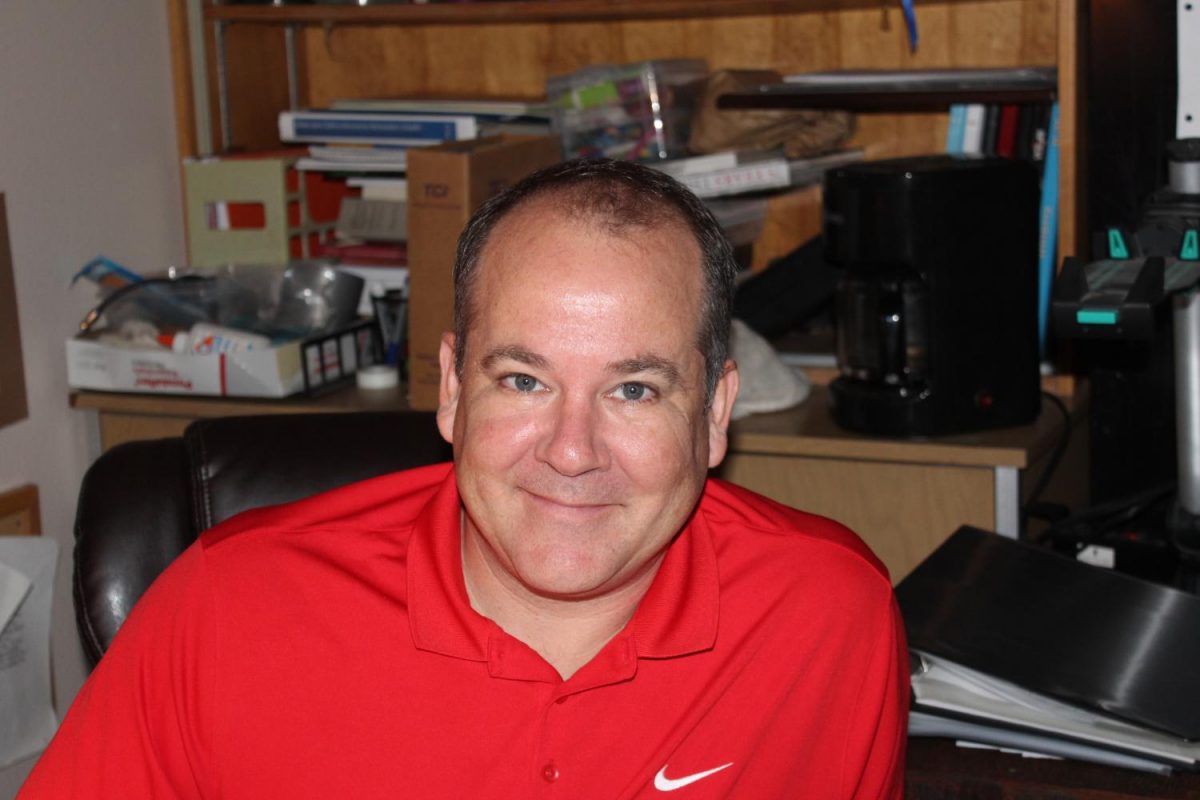Coaches Discuss Athletics At Roundtable
Head Basketball Coach John Poetsch discusses the overall athletic program at the high school.
Talon member Jessica Villalobos met with several coaches last month at an early-morning round-table. The topic: What’s happening to Centennial sports, and what can be done to stop the decline? Those in attendance were Head Coaches Chris Knudsen (recently retired/football), Roger Mathews (wrestling), John Poetsch (boys basketball), Luke Franzke (track), Gregg Letts (track and cross country), Steve Baker (softball) and Jeff Stanek (girls basketball). Athletic Director Brent Child also attended.
By all accounts, most Centennial athletics have taken a step backwards over the past two decades. This decline is measurable in three ways: The number of wins in each sport, the inconsistency from season-to-season, and the number of players in each sport.
Twenty years ago Centennial was competitive at the State level in most sports. Nowadays consistently breaking the .500 mark in league play is a lofty goal for some sports. And good seasons are often followed by another rebuilding stretch. For example, in 2016 the football team competed for a league title and fared well in the playoffs, but in 2017 the team fell to 2-7.
The same is true for most team sports. There have been some individual state champions–Jamie Stone (swimming) and Phillip Kue (wrestling), for example–but team sports have struggled of late.
“We are at a critical time in regard to athletics in our district,” said Athletic Director Brent Child.
Nearly every CHS coach echoes Child’s statement that changing demographics and budget cuts have been the main factors for a decline in athletics.
Due to budget cuts, most middle school and youth programs have been removed from the district. This has lead to a decrease in participation, skills, and competitiveness in high school sports. The lone exception is track and field, which is still offered at the middle school. All other middle school sports have been eliminated.
“You can’t eliminate the training ground and expect the high school to fix things in a four-year period,” said Head Girls Basketball Coach Jeff Stanek. “Kids might be interested in a sport as freshmen but when they don’t have any success there is not always a lot of interest in continuing. Losing zaps the enthusiasm pretty quickly.”
“Cutting middle school sports impacts the high school turnout and creates more obstacles for the high school coaches,” said Assistant Football and Basketball Coach BJ Basinski.
In the past there were multiple middle sports offered including as many as four football, basketball and volleyball teams–two at each level–and a full-schedule for wrestling team.
Now, “no cultural of athletes is being developed,’’ said Child.
Wrestling coach Roger Mathews said students are not used to the commitment or competitiveness once they reach high school level. He said the wrestling program offered at the middle school through the SUN program is recreational and sporadic at best.
“Kids get to high school and are shocked that we expect them to practice five or six days a week for two hours, and that the season lasts four months,” said Mathews. “They are used to getting a snack after school (through the SUN program) then having a 20-30 minute practice, followed by another treat and then a bus ride home. It’s culture shock when they get here.”
“Sports are a great classroom for learning and we need to bring back middle school sports, develop competitive youth program – these are just vital to have at the high school level,” said Child.
While nobody blames Child for the situation–quite the contrary, the coaches are appreciative of his efforts–part of the issue is that he is only able to control athletics at the high school and nowhere else in the district. “There’s no district athletic director so there’s no vision,” said Head Basketball Coach John Poetsch. “Things need to be aligned from elementary to high school.”
Nobody argues that extra-curricular activities including sports help students stay on top of attendance, grades, and good behavior during and after school hours. Therefore cutting middle school sports seems a little short-sided to many coaches. Head Football Coach Chris Knudsen goes a step further and says he is puzzled at the cuts with society’s emphasis on fitness and healthy lifestyles.
Having youth programs gets the kids exposed to the sports and help master the basic skills and concepts of the game.
Knudsen started youth programs in 1995. “It helped us tremendously to be more successful, but it’s been a lot of work to keep them going,” he said. Knudsen did this in lieu of the middle school sports because the kids needed more than was being offered.
“We have held pretty steady because of our youth programs,” said Knudsen. Knudsen has been able to maintain a large group of players, but despite the numbers, many players still don’t come into high school with the skills or fundamentals.
“There is some movement to get other sports going better with time, but nothing has been started, only getting established,” said Knudsen.
Head Softball Coach Steve Baker, who also coaches soccer and wrestling, noticed a decline in all sports in the late 80’s and into the 90’s when more than half of recreational teams in softball and soccer were cut.
“Its happening everywhere in the East County; there’s fewer people playing every sport,” Baker said.
“Once they pass that critical period of time (to develop skills), it’s tough to ever get them started,” said Poetsch. “They can’t afford to play, so numbers are too low to play and we don’t have teams.”
Baker also mentioned the increase in prices for competitive club teams, which reduces the participation and skill level that comes to high school. It’s not unheard of for high school athletes at more affluent schools–West Linn, Lake Oswego, Jesuit, Lincoln, for example–to pay thousands of dollars a year to specialize on their sports outside of the high school season.
According to many coaches, this brings a second major problem to the table. Not only has the district cut middle school sports for budget reasons, but at about the same time the decision was made to charge indoor sports for practice times for youth sports. This severely hampers indoor sports coaches’ ability to build a program, say many coaches, especially given the community’s low socio-economic status.
“They (district officials) charge for heat and light, but other (outdoor) programs don’t have to do that. It’s a death nail, we can’t afford to have that additional cost; it’s another barrier for entry to play,’’ said Poetsch.
Stanek agrees, “(In many cases) we are required to fill out a building use form and pay $54 an hour when the outdoor sports can go out and play at any time.”
The “decline” in CHS sports has been an ongoing dilemma for the past 15 years, despite coaches pushing district officials in bettering conditions for sports at Centennial. They are slowly seeing more cooperation–Poetsch recently had a meeting with the district office.
The problem is bigger than a token change can fix, said Stanek. “Rebuilding a program is a 5-year or longer process,” he said. “This is not going to get better quickly.”






